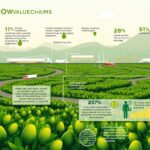Global Insight: How Secret Forest Roots and Hidden Networks Are Rescuing Our Climate
Forests are dynamic ecosystems, not just collections of trees. They regulate climate through deep root systems and mycorrhizal networks—often called the “wood wide web”—that transport water, nutrients, and carbon. These underground processes are crucial for climate regulation, soil carbon recovery, and ecosystem resilience. This article overviews forest ecosystems, hidden networks, reforestation techniques, ecosystem threats, and the future prospects of forest-based initiatives, offering actionable insights for policymakers and environmental enthusiasts.
What Are Forest Ecosystems and Their Role in Climate Change?
Forest ecosystems are complex communities of trees, understory plants, animals, microbes, and fungi. They act as massive carbon sinks, removing CO₂ from the atmosphere; forests account for nearly 30% of global terrestrial carbon storage. The biomass—from canopies to forest floors—captures and stores carbon, mitigating greenhouse gas emissions.
Forests also affect weather patterns by releasing water vapor and generating cloud cover, which influences precipitation. Their energy exchange with the atmosphere moderates local temperatures, reducing extremes and enhancing resilience against drought and floods. Through photosynthesis, forests convert CO₂ into organic matter, releasing oxygen that supports biodiversity. When deforestation or degradation occurs, this critical carbon balance is disrupted, leading to more emissions.
Additionally, forests stabilize soil, filter water, and provide habitats for countless species. Intact tropical forests, for instance, can capture more than 10 tons of carbon per hectare annually. Overall, forests are indispensable natural regulators in our fight against climate change.
Which Forest Types Are Key to Global Carbon Storage?
Different forest types store carbon differently. Tropical rainforests, with their biodiversity and dense vegetation, hold about 20% of the world’s terrestrial carbon. Temperate deciduous forests, with seasonal cycles, efficiently cycle carbon into soil organic matter. Boreal forests, or taiga, in cold regions lock carbon in peat and soils over centuries. Although each type contributes uniquely—whether through rapid growth or long-term storage—the preservation of all is critical; degradation quickly releases stored carbon and disrupts global budgets.
How Do Forests Act as Carbon Sinks to Mitigate Global Warming?
Forests sequester carbon through photosynthesis. Trees absorb CO₂ and convert it into organic compounds, storing carbon in trunks, branches, leaves, and roots. Decaying organic matter further aids long-term carbon retention in soils. Mature forests can sequester several tons of carbon per hectare annually. Their efficiency depends on species composition, age, and management practices. In addition, dense canopies lower the land’s albedo, absorbing more sunlight to fuel photosynthesis and enhance carbon capture. This synergy is crucial to reducing atmospheric CO₂ and mitigating global warming.
What Are the Main Threats to Forest Ecosystems Today?
Forest ecosystems face threats from human activities and natural disturbances. Deforestation for agriculture, urbanization, and logging shrinks forest cover, reducing biodiversity and carbon storage. Climate change, with rising temperatures, prolonged droughts, and frequent fires, further stresses forests and accelerates carbon emissions. Invasive species, pests, and diseases also destabilize these systems.
Such threats reduce not only forest area but also their ability to provide essential services like carbon sequestration and soil protection. Fragmentation isolates wildlife, diminishes genetic diversity, and undermines overall ecosystem resilience. Addressing these challenges through protection policies, sustainable management, and reforestation is critical to preserving forest functions and stabilizing the climate.
How Do Forest Ecosystems Support Climate Resilience?
Forest ecosystems strengthen climate resilience by buffering extreme weather, stabilizing soil, and sustaining water cycles. Extensive root networks improve soil structure and prevent erosion, while tree canopies moderate local temperatures. Biodiversity within forests ensures adaptive responses to stressors. The symbiotic relationships—especially mycorrhizal networks—enhance nutrient cycling and overall ecosystem health. Integrated management approaches combining conservation, reforestation, and sustainable use not only preserve ecological integrity but also support local communities economically and socially, bolstering overall resilience.
What Are Hidden Networks in Forests, and Why Do They Matter?
Hidden networks, particularly mycorrhizal associations, are critical for forest function. These networks connect trees via symbiotic fungi that transfer water, nutrients, and chemical signals, supporting overall plant health and stress tolerance.
Through these fungal bridges, older trees can share carbon with younger seedlings, stabilizing forest composition. The networks also help detect and respond to stressors like pests or drought. By forming stable soil aggregates and promoting nutrient cycling, mycorrhizal networks enhance water retention and soil fertility, thereby supporting robust carbon sequestration and ecosystem stability.
What Are Mycorrhizal Networks and the Wood Wide Web?
Mycorrhizal networks are symbiotic links between fungi and plant roots. Fungi extend far beyond the reach of tree roots, absorbing nutrients and water and delivering them to the host plant in exchange for carbohydrates. Known as the wood-wide web, this vast interconnected system allows multiple plants to share resources, signal distress, and coordinate defenses against pathogens. It is a natural superhighway of information and resources that bolsters drought resistance and increases carbon storage capacity, underlining its role in mitigating climate change.
How Do Mycorrhizal Networks Enhance Nutrient Uptake and Soil Health?
By extending the effective root area, mycorrhizal networks significantly improve nutrient and water uptake. Fungal hyphae explore larger soil volumes and secrete enzymes that break down organic matter, releasing nutrients in plant-accessible forms. They help form stable soil aggregates that improve water retention and aeration, making soils more resilient. Overall, these benefits not only support individual tree growth but also enhance the entire forest’s ability to sequester carbon and endure environmental stresses.
In What Ways Do Hidden Networks Facilitate Carbon Sequestration?
By promoting more vigorous plant growth and improving soil structure, hidden networks directly increase biomass and stabilize carbon in soils. Healthier trees store more carbon in all tissues, and the improved organic matter content slows decomposition rates, reducing carbon loss. Forests with intact mycorrhizal networks can sequester markedly more carbon than disturbed ones, which underscores their importance in global carbon budgets and long-term climate regulation.
What Research Supports the Importance of These Hidden Networks?
Long-term studies in North America and Europe have shown that trees connected by mycorrhizal networks grow faster and survive droughts better than isolated trees. Disruption of these networks—whether by soil disturbance or chemical treatments—leads to reduced carbon sequestration and poorer plant health. Meta-analyses suggest that intact networks boost carbon storage by up to 25%, emphasizing the need for preserving both aboveground and belowground forest components.
How Do Forest Roots Contribute to Climate Recovery and Soil Carbon Storage?
Forest roots anchor trees and are vital for both nutrient uptake and soil structure. Deep roots access carbon far below the surface where decomposition is slow, locking in carbon for extended periods. Fine roots, which turn over rapidly, continually add organic matter to soils. Together, they adjust soil porosity and moisture, creating fertile conditions that enhance long-term carbon storage.
Roots interact closely with mycorrhizal fungi, which expand nutrient exchange and improve soil aggregation. Root exudates also stimulate microbial activity that converts atmospheric carbon into stable soil compounds. Thus, the complex architecture and function of roots are fundamental to forest-driven climate recovery and soil carbon accumulation.
What Is the Role of Root Architecture in Carbon Sequestration?
Root architecture—the depth, density, and spread of roots—determines how effectively a forest can sequester carbon. Deep taproots store carbon in stable subsoil layers, while a dense network of fine roots adds carbon continuously through turnover. Enhancing root density through selective reforestation practices can increase carbon storage by up to 30%. Understanding these architectural traits is key to designing strategies that maximize natural carbon sequestration.
How Do Roots Improve Soil Health and Ecosystem Stability?
Roots reinforce soil structure, reduce erosion, and foster the formation of stable soil aggregates that boost water infiltration and retention. The decomposition of dead roots enriches soils with organic matter, which in turn supports diverse microbial communities essential for nutrient cycling. This synergy not only maintains soil fertility but also underpins overall ecosystem stability and resilience.
How Are Root Systems Affected by Climate Change?
Climate change alters precipitation patterns and raises temperatures, which can stifle root growth and nutrient uptake. Excess moisture may cause root rot, while drought limits water availability. Additionally, disturbances in the symbiotic balance between roots and mycorrhizal fungi can reduce carbon sequestration. Some tree species adapt by growing deeper roots or increasing fine root production, but overall, a diverse, mixed-species forest is crucial for maintaining robust root systems in a changing climate.
What Innovations Are Advancing Root Research for Climate Solutions?
New technologies like ground-penetrating radar, isotopic labeling, and remote sensing enable detailed mapping of root systems. These tools help quantify the contribution of roots to carbon storage, while genetic and molecular techniques identify species with superior root traits. Combining knowledge from different fields like ecology and engineering is creating nature-inspired solutions that imitate how roots work in cities and farms, helping improve efforts to plant new forests and restore existing ones.
What Are Effective Reforestation Techniques for Climate Solutions?
Reforestation restores canopy cover and revives degraded lands, recapturing lost carbon sequestration capacity. Effective techniques consider careful site selection, species diversity, and ongoing management. Approaches include assisted natural regeneration—supporting indigenous species through soil stabilization—and active reforestation that directly plants trees, allowing precise species selection and density control. Hybrid methods combine planting with protective measures like biodegradable tree shelters and mycorrhizal inoculants to boost seedling survival and accelerate recovery.
Innovative techniques such as agroforestry integrate trees with agricultural practices, enhancing carbon capture while providing economic benefits. Urban reforestation, which improves air quality and reduces heat islands, is also gaining traction. Success depends on choosing species well-adapted to local conditions, community engagement, robust funding, and clear policy support.
How Do You Choose the Right Tree Species for Reforestation?
Selecting tree species involves assessing local adaptability, growth rates, carbon sequestration potential, and resistance to pests. Native species are preferred for their compatibility with local conditions, and mixed-species plantations enhance resilience against environmental stressors. Field trials and ecological assessments determine optimal planting density and spacing, ensuring that reforestation maximizes ecological benefits and supports long-term sustainability.
What Are the Differences Between Planting and Natural Regeneration?
Planting involves propagating and inserting seedlings into a controlled environment, offering immediate restoration benefits and targeted species selection. In contrast, natural regeneration relies on existing seed banks and root sprouting, promoting gradual recovery that preserves genetic diversity. Although natural regeneration is cost-effective and sound ecologically, active planting may be necessary in severely degraded areas. Often, we employ a combined strategy to maximize outcomes.
What Best Practices Ensure Reforestation Success?
Successful reforestation requires thorough site assessments, biodiversity preservation, and adaptive management practices. Continuous monitoring, community participation, and innovative technologies—such as drone-assisted seed planting—contribute to long-term project success. Integrating socio-economic benefits, like local employment and training, ensures that reforestation efforts are sustainable and supported by communities.
Which Case Studies Demonstrate Successful Reforestation Projects?
Projects like Kenya’s Green Belt Movement and Brazil’s Atlantic Forest Restoration Pact provide powerful examples. These initiatives have restored millions of hectares of degraded land, improved local livelihoods, enhanced biodiversity, and increased carbon storage, demonstrating the potential of well-managed reforestation to drive both environmental and socio-economic recovery.
What Funding and Incentives Support Reforestation Efforts?
Reforestation is often supported by government programs, international grants, and private investments. Mechanisms such as carbon credits, payments for ecosystem services, and community-based management schemes encourage sustainable practices. For instance, the European Union has invested significantly in afforestation projects as part of its broader climate action strategy, illustrating the integration of environmental conservation with economic incentives.
How Do Forests and Hidden Networks Build Climate Resilience Through Trees?
Forests and their hidden networks form natural infrastructure that enhances climate resilience by mitigating extreme weather, conserving water, and maintaining biodiversity. Trees buffer against drought and floods while regulating water cycles. The synergy between aboveground vegetation and belowground mycorrhizal networks enables nutrient redistribution in times of stress, allowing even weakened trees to recover. Moreover, forests moderate local temperatures through transpiration and shading.
Diverse forests are more likely to withstand invasive species, pest outbreaks, and extreme weather events. Strong mycorrhizal networks, bolstered by high species diversity, promote ecosystems that are consistent buffers against climate variability. Strategies for climate-resilient management include mixed-species planting and reducing fragmentation, which together sustain continuous ecosystem services locally and globally.
How Do Forests Help Mitigate Drought and Flood Risks?
Forests conserve soil moisture through deep roots and reduce evaporation via their canopies. In droughts, these features maintain water availability, while in heavy rains, dense cover slows runoff, allowing soils to absorb water and reduce flood risks. This dual function safeguards water supplies and protects downstream communities from extreme events.
What Role Do Mycorrhizal Networks Play in Forest Resilience?
Mycorrhizal networks are essential for resource sharing among trees. They boost nutrient uptake and water-use efficiency, distributing stress signals that help the forest collectively adapt to changes. This interconnected support system reinforces the resilience of individual trees and the entire forest community against stressors such as drought or nutrient deficiencies.
How Does Biodiversity Support Climate Resilience in Forests?
Biodiversity fosters complex interspecies interactions that stabilize ecosystem processes. Diverse plant communities can fill a wider range of ecological niches, adapt more readily to changes, and sustain continuous carbon sequestration and nutrient cycling. Genetically varied tree populations are more resistant to pathogens and environmental stress, thus bolstering the overall resilience of the forest.
What Are the Long-Term Benefits of Climate-Resilient Forest Management?
Long-term benefits include sustained carbon sequestration, improved water quality, and enhanced ecosystem stability. Climate-resilient management not only addresses immediate risks like floods and droughts but also creates conditions favorable for biodiversity, economic development, and community well-being. Integrating local stakeholders in forest management fosters sustainable practices and shared stewardship.
What Are the Global Impacts and Future Prospects of Forest Roots and Hidden Networks on Climate?
Forest roots and hidden networks are vital components of the global carbon cycle and climate regulation. They store vast amounts of carbon, stabilize soils, and facilitate nutrient cycling—functions that yield profound economic and environmental benefits. Healthy forests lower atmospheric CO₂, mitigate extreme weather, and support biodiversity, all of which are key to sustainable development and climate adaptation.
Recent models suggest that these underground systems store billions of tons of carbon, helping offset human emissions and contributing to targets like those in the Paris Agreement. Continued advancements in research and technology are enhancing our understanding of these processes, leading to innovative climate interventions. In addition to reduced disaster management costs and improved agricultural productivity, these systems also generate potential revenue through carbon trading.
International collaborations and funding initiatives underscore the importance of preserving these systems as a cornerstone of global climate resilience.
How Much Carbon Do Forest Roots and Networks Store Worldwide?
Estimates indicate that forest roots and associated soil organic matter store between 1,500 and 2,500 gigatons of carbon. This long-term reservoir plays a key role in regulating atmospheric CO₂ and buffering against rapid emissions, with storage capacity influenced by forest type, climate, and management practices.
What Are the Economic and Environmental Benefits of Protecting These Networks?
Protecting these networks leads to reduced costs in flood control, soil erosion, and disaster recovery. Moreover, they offer economic opportunities through sustainable timber production and carbon credit schemes while enhancing water quality, biodiversity, and air purification. These benefits collectively ensure greater ecosystem stability and long-term sustainability.
How Are Organizations and Scientists Advancing This Field?
Collaborative research by academic institutions, governments, and NGOs—supported by agencies such as UNEP and the European Union Joint Research Centre—is expanding our understanding of forest roots and mycorrhizal networks. Cutting-edge remote sensing and soil analysis techniques are helping to quantify carbon storage and inform policies that integrate soil conservation with broader climate actions.
What Emerging Trends Will Shape Forest-Based Climate Solutions?
Emerging trends include precision forestry using satellite imagery and drones, ecosystem restoration that integrates local and indigenous knowledge, and innovative practices like biochar application and mixed-species planting. These advances are paving the way for more resilient, sustainable forest management that can effectively address both mitigation and adaptation challenges.
How Can Individuals and Policymakers Support Forest Network Conservation?
Support can be provided by advocating for sustainable land-use policies, engaging in community-led tree planting, and promoting conservation initiatives. Policymakers can enforce regulations, fund research, and offer economic incentives to ensure robust forest management. Collaborative efforts at all levels are essential to protecting these natural climate regulators.
Table: Key Attributes and Benefits of Forest Roots and Hidden Networks
Before diving further, consider the following table summarizing the key attributes and benefits:
Frequently Asked Questions
Q: What exactly are forest ecosystems, and why are they important for climate change mitigation?
A: Forest ecosystems are complex networks of trees, plants, animals, and microbes. They act as natural carbon sinks by absorbing CO₂ through photosynthesis and storing it in biomass and soils, which helps moderate global temperatures and supports biodiversity.
Q: How do mycorrhizal networks enhance nutrient uptake in forests?
A: These networks form symbiotic relationships between fungi and plant roots, expanding the effective area for water and nutrient absorption, which supports better tree growth and overall forest health.
Q: What are the main challenges facing forest ecosystems today?
A: Key challenges include deforestation, climate change-induced droughts and floods, invasive species, and soil degradation, all of which reduce forest cover and impair their ability to sequester carbon.
Q: How can reforestation contribute to climate resilience?
A: Reforestation restores degraded lands, increases carbon sequestration, improves soil health, stabilizes local climates, and enhances ecosystem services, thereby mitigating climate change and supporting sustainable communities.
Q: What innovations are advancing our understanding of forest roots and hidden networks?
A: Technologies such as ground-penetrating radar, remote sensing, and isotopic labeling, along with advances in genetic analysis, are offering comprehensive information on root systems and mycorrhizal networks to optimize forest management practices.
Q: How can policymakers and individuals support the conservation of forest networks?
A: Through strict conservation policies, funding sustainable forestry projects, community-led tree planting, and advocating for supportive regulations, both individuals and governments can help preserve these crucial networks.
Q: What are the long-term benefits of maintaining healthy forest ecosystems?
A: Healthy forests ensure sustained carbon sequestration, improved air and water quality, enhanced biodiversity, and greater resistance to climate extremes, leading to economic savings and better human health.
Final Thoughts
Forest ecosystems, with their hidden networks and robust root systems, are the backbone of our planet’s climate resilience. Their ability to store carbon, enhance soil fertility, and stabilize local climates is critical for mitigating the impacts of climate change. Strategic reforestation and sustainable forest management are not only environmental imperatives but also key drivers for economic and social well-being. Embracing these natural solutions today will pave the way for a more stable and sustainable future.









































































































